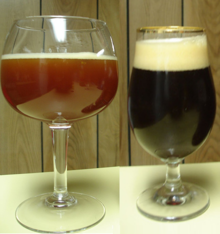Barley wine

Barley wine or Barleywine is a style of strong ale originating in England in the nineteenth century (derived from the March or October beers of the 18th century) but now brewed worldwide. The first beer to be marketed as Barley Wine was Bass No. 1 Ale, around 1900. The term "barley wine" had been used before in other contexts,[1] for example in translations of Xenophon's Anabasis (although it may have referred to regular grape wine with cooked barley in it).[2]
Characteristics
A barley wine typically reaches an alcohol strength of 8 to 12% by volume and is brewed from specific gravities as high as 1.120. It is called a barley wine because it can be as strong as wine; but since it is made from grain rather than fruit, it is in fact a beer. In the United States, barley wines are required for this reason to be called "barley wine-style ales." Though this could be taken by some to imply that they are not truly barley wines, in fact it only means that they, like all barley wines, are not truly wines.
Its natural sweetness is usually balanced with a degree of hoppy bitterness, though traditional English barley wines often have far less bitterness than their American counterparts.
This beer is meant for slow sipping and savouring of its fruity, high-alcohol and well-aged character. It is brewed often to celebrate events and the high levels of both hops and alcohol allow some barley wines to be aged for years, much like wines.
Most barley wines range in colour from amber to deep reddish-browns, though until the introduction of Whitbread Gold Label in the 1950s, British barley wines were always dark in colour.
The late Michael Jackson referred to a barley wine by Smithwick's. He said: "This is very distinctive, with an earthy hoppiness, a wineyness, lots of fruit and toffee flavours." He also noted that its original gravity is 1.062.[3]
Style statistics
- Original gravities: 1.090-1.120
- Alcohol: 8.5-12 percent
- Bitterness: 50-100 IBU (International Bitterness Units)
- Color: 24-48 EBC (European Brewery Convention)
Examples
Australia
- Special Reserve from Redoak Brewery
Canada
- Olde Deuteronomy from Alley Kat Brewing Company
- Solstice d'hiver from Dieu du Ciel
- St-Ambroise Vintage Ale from McAuslan Brewing Company
- Burlywine from Half Pints Brewing Company
- Barley Wine from Mill Street Brewery
Ireland
- Smithwick's Barley Wine from Diageo
United Kingdom
- Bass No 1 Barley Wine from White Shield Brewery (brewed occasionally)
- Elizabethan Ale from Harvey & Son
- Gold Label from Whitbread
- Golden Pride from Fuller's
- Old Nick from Young's
- Old Tom from Robinson's Brewery
- Thomas Hardy's Ale from O'Hanlon's, Devon
- Headcracker from Woodforde's Norfolk Ales, Norfolk
- JW Lees's Vintage Harvest
New Zealand
- Enigma from The Twisted Hop
Sweden
- Nils Oscar Barley Wine from Nils Oscar Bryggeri och Bränneri
United States
- Bigfoot Ale from Sierra Nevada Brewing Company
- Old Crustacean from Rogue Ales
- Old Foghorn from Anchor Brewing Company
- Old Guardian from Stone Brewing Company
- Old Horizontal from Victory Brewing Company
- Old Ruffian from Great Divide Brewing Company
- Olde School from Dogfish Head Brewery
- Monster Ale from Brooklyn Brewery
See also
References
- ^ Rundell, M.E. The new family receipt book.
- ^ Xenophon. The Whole Works of Xenophon (1832).
- ^ "Brewery with its own abbey - it must be Ireland" FEB 1, 1993
